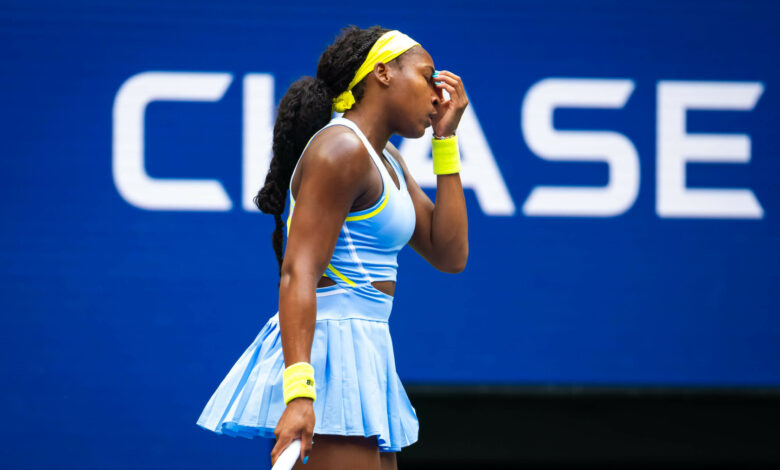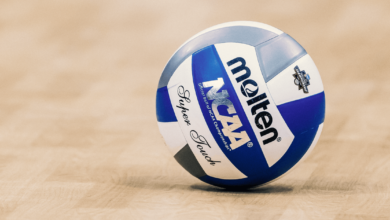Coco Gauff knocked out of US Open by Emma Navarro

NEW YORK — For Coco Gauff, the biggest star in American tennis who took complete control of the US Open last year, a triumphant sequel was not in the cards.
Gauff, playing with the brilliant, challenging and frustrating instability that had characterised her tennis all summer, lost in three sets to compatriot Emma Navarro on Sunday afternoon, ending her Grand Slam season without realising her hopes of continuing last year’s magical run with another trip to the winner’s circle.
For the second consecutive time in a major tournament, Navarro, Gauff’s Olympic teammate, used her increasingly dangerous combination of tenacity, speed and power to defeat her, beating the world No. 3 6-3, 4-6, 6-3.
Navarro, 23, a New York native who grew up in South Carolina, is quickly becoming a force in tennis. She smothered the reigning champion in front of Serena Williams, Stephen Colbert, Michael Che and nearly 24,000 fans at Arthur Ashe Stadium. Navarro defied the pressure and drama of the occasion and turned the match into an exercise in tennis simplicity. Navarro played cleanly. Her strokes, fundamentally sounder and more reliable than Gauff’s tightrope act, were the deciding factor. She delivered.
Navarro, who has risen significantly in the rankings over the past year, became an NCAA champion with the Virginia Cavaliers. Now she is No. 13 at her home Grand Slam and she is still climbing, her weaknesses diminishing with each passing month.
“It’s pretty crazy,” Navarro said. “This is the city where I was born and it feels so special to be playing here.”
This was going to be a tough matchup for Gauff anyway, not least because of the inevitable scar tissue from losing at Wimbledon in July. Gauff went into that match as a favorite not only to beat Navarro but to reach the final. So many other top players had already fallen.
Then Navarro came to the net and did what she’s been doing all year, really. She ran ball after ball, extended rallies and simply refused to miss, holding on long enough for Gauff’s Achilles heels—the instability of her forehand and her serve—to fail her.
On Sunday, she brought all that and more. Block returns of Gauff’s 120-mph serves went deep enough to send her back down. Stab returns of apparent winners stole points. And on a hot, still, humid afternoon, she proved her fitness is equal to that of Gauff, who is known as just about the fittest player in the game.
Gauff didn’t help herself, double-faulting 19 times, often at key moments. Two double-faults gave Navarro a service break in the first set, and another halfway through the second set brought Navarro a break point. When she saved a Gauff drop shot and hit a forehand down the line for a winning shot, the end seemed nigh.
Then the wobbling started.
Two ugly service games, full of wild forehands and tentative shot-making, gave Gauff a new lease of life when all seemed lost. She put her finger to her ear to get some sound as she got the first break of service, and asked the crowd that had rooted her to a trophy 12 months ago to do it all again.

GALLING DEEPER
Old friends know best: why Coco Gauff will be the least surprised by a loss to Emma Navarro
It was a risky move against a friend, compatriot and Olympic teammate, but she needed all the help she could get. And she certainly wasn’t trying to calm anyone down when she came out on top and the stadium exploded in front of her.
“It was tough to lose the second set. I had chances,” Navarro said.
Gauff’s reprieve was indeed brief. A series of double faults, including two to give Navarro the early break of service in the deciding set, halted her momentum and sent her tumbling. Navarro improved her act and found new life in her legs. This time, she didn’t let the luck of Gauff’s gifts slip off her racquet.
After Gauff made her second double fault in the final game and Navarro was two points from the finish line, she turned her head to her box and nodded.
Two points later, she showed the athleticism and instincts that have surprised most pro tour players this year by dropping into a split, nearly sitting in the court to fire a backhand return down the line. When Gauff’s forehand sailed long and wide, Navarro was on her way to her second Grand Slam quarterfinal, where she will face Paula Badosa of Spain. Badosa, a former world No. 2, is suddenly hot after spending most of the past year nursing a back injury.
“Coco is a great player. I know she’ll come back and win this thing again,” Navarro said.

Emma Navarro’s ironclad play was too much for Coco Gauff at Arthur Ashe Stadium. (Robert Prange/Getty Images)
For Gauff, the loss is the latest in a disappointing summer that began with a semifinal defeat to world No. 1 Iga Swiatek at the French Open. For months before that, going back to August 2023, before she fell triumphantly to the floor in this stadium, she had been one of the most bankable players in the game. She hadn’t cured herself of her weaknesses, but she had found ways to disguise them, playing more safely, hitting big forehands to extend her points and making her matches more physical.
She started to push her throw further back on her serve to prevent herself from charging up the court.
Since that loss to Swiatek, opponents have found ways to counter her new strategies. The fickleness in her game that stabilized those strategies is back. Gauff has been out early, at least for her; in some losses, the growing tension between her and her head coach, Brad Gilbert, was obvious.

Coco Gauff’s forehand broke under pressure from Emma Navarro’s fluid ground strokes. (Angela Weiss/AFP via Getty Images)
In the loss to Navarro at Wimbledon, Gauff begged Gilbert to give her a plan to avert the inevitable. In a win earlier in the week, she begged Gilbert and everyone in the box to stop talking to her.
There was little visible tension between Gauff and her box Sunday. But long-term relationships between coaches and players are increasingly rare.
For Navarro, this victory is a new, solid piece of evidence to support the long-standing feeling that these two players will spend a lot of time together in the future, at the top of the rankings and in the final rounds of the biggest tournaments. Navarro is three years older than Gauff, but they have known each other since their early years in junior tennis and have been friends with each other. Gauff was a prodigy then, playing two and three age groups higher, and Navarro was just a normally gifted player.
Everything about them seems in contrast. Gauff is a product of the growing black middle class. Navarro is the daughter of a banker and her family is among the wealthiest in the country.
Gauff won matches at Wimbledon at the age of 15, defeating Venus Williams in 2019.
Navarro attended college but blossomed late in life thanks to her reputation as one of the hardest-working players in the sport.
Navarro has lost in the first round of the US Open for the past two years. Gauff has been busy establishing herself as a fixture in the second week and at Arthur Ashe Stadium, where she cemented her place as a cultural icon by winning her first Grand Slam.
Navarro had never played at Ashe before Sunday, and the schedule didn’t allow her to warm up beforehand. She had played on big courts before, including Centre Court at Wimbledon in July, but some of those moments had overwhelmed her.
Not Ashe, she said. She felt at ease from her first moments there, even with the roar of the crowd.
“I had prepared myself for the worst, just in terms of feeling overwhelmed and nervous,” she said. “It’s a pretty crazy court. The energy in New York is unmatched.”
After Gauff’s win last year, she said she had a song stuck in her head for days. Then she launched into the chorus of the Alicia Keys and Jay-Z collaboration, “Empire State of Mind.”
Moments after she and Navarro embraced at the net after the final point and Gauff slung her bag over her shoulders to walk slowly and sadly off the court, that song blared from the stadium’s loudspeakers.
Gauff later gave Navarro a lot of credit. She also acknowledged how easy she made it for her, especially with all those double faults. She said the problem is that she lowers the left or front side of her body too quickly when she pulls her racket through the ball.
Does she know anything else? There is something emotional that prevents her from throwing the ball in the box. On the practice field, she can land 30 bombs in a row.
She wants help.
“I don’t want to lose these kinds of matches anymore,” she said.
She knows other players would do anything to have had a summer like hers, reaching the last 16 at Wimbledon and the US Open and carrying her country’s flag at the opening ceremony of the Olympics.
“I want to get to another level,” she said. “It’s disappointing, but I’m not going to beat myself up and say, this was so bad. Yes, I expect better, but at the end of the day, it happened and I know I can turn it around.”
She plans to work on that in the coming months. There are still some tournaments to play, but her priority is a solid training block, a rare event for top players who have to struggle through the almost 11-month season.

Emma Navarro recovered from a slump under the pressure of Arthur Ashe Stadium and played solid tennis, which would lead her to victory. (Timothy A. Clary / AFP via Getty Images)
Navarro doesn’t think much about training blocks now, with a quarterfinal to go. It’s all happened so quickly, it’s exceeded her expectations and those of so many others. Just over two years ago, when she left university, she and her coach agreed to two years of tour tennis, no matter what. Then they would evaluate where she was, what was possible and whether it would be worth it.
The time for that deal expired in June. They didn’t even talk about it.
“I believe I can play tennis with the best players in the world,” she said. “I deserve to be on this stage, and I belong in these rounds of Grand Slams.”
(Top photo: Robert Prange/Getty Images)




